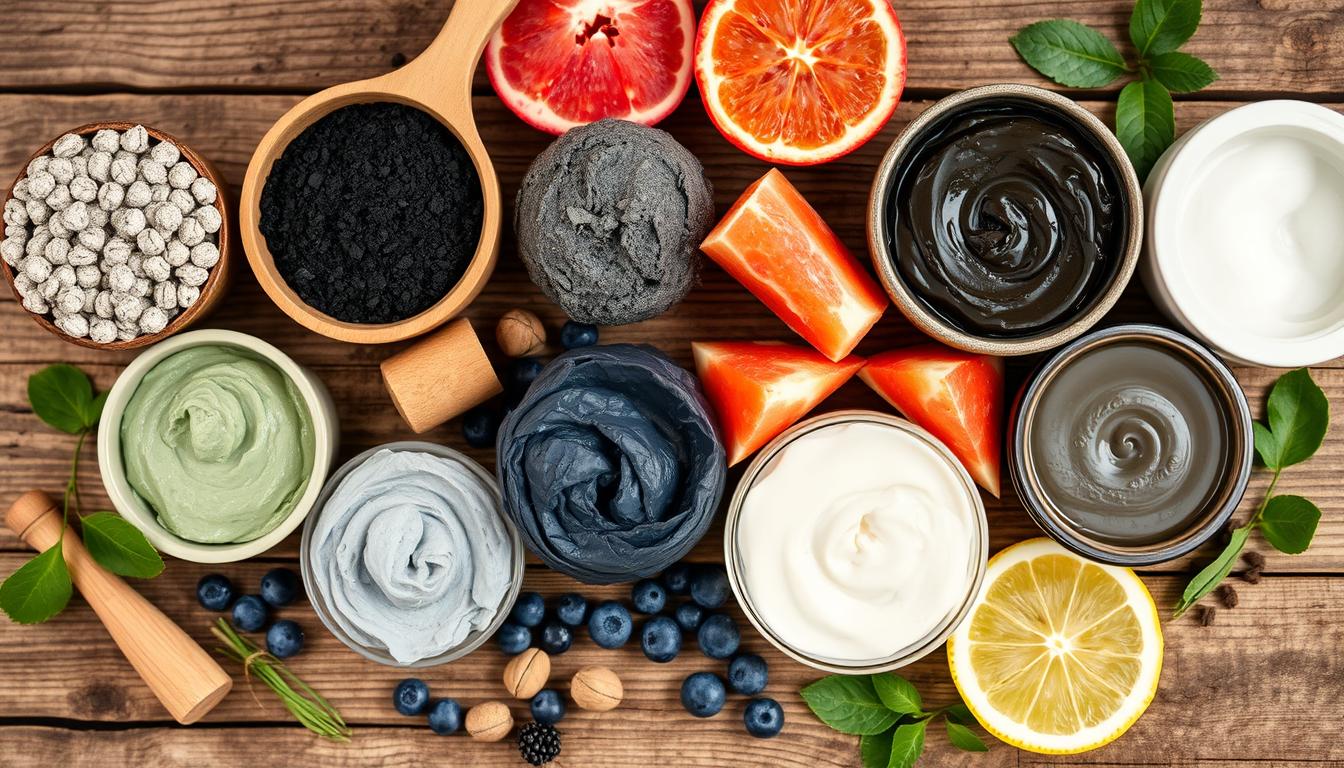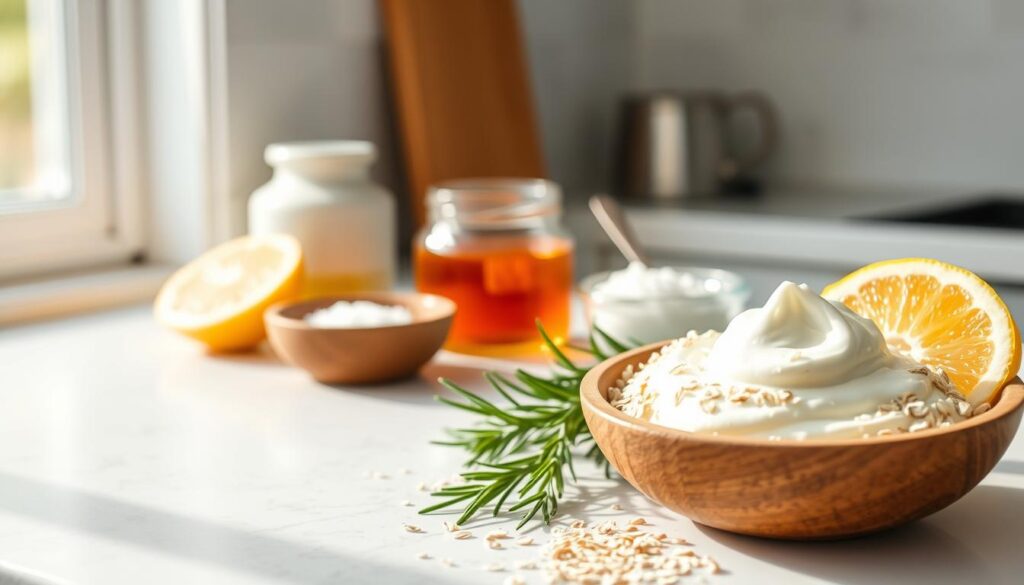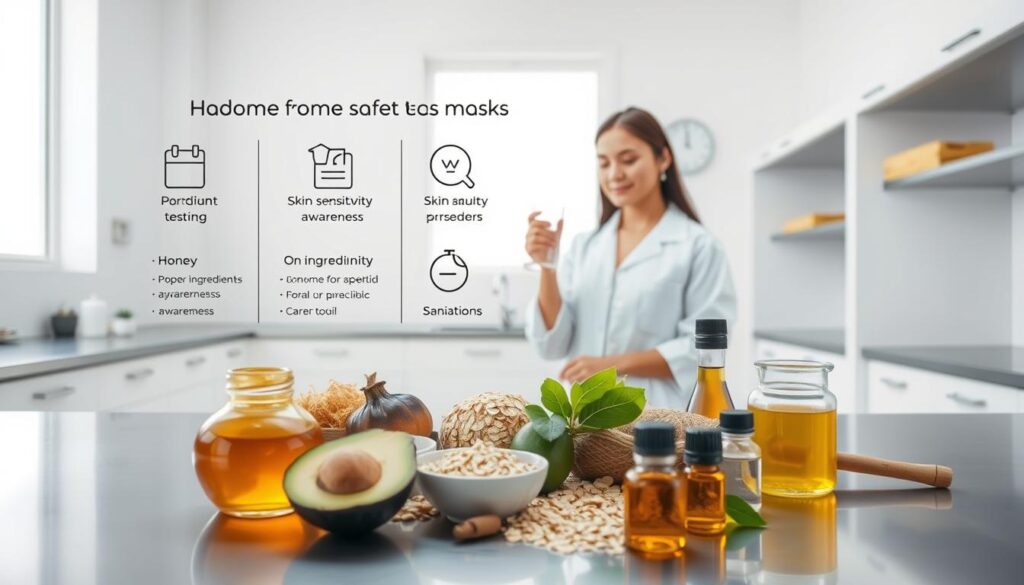10 DIY Natural Face Masks for Glowing Skin

Imagine turning your kitchen into a place for skincare. DIY face masks have changed how we care for our skin at home. They are natural and cheaper than store-bought treatments. With simple ingredients, you can make masks that feed, heal, and brighten your skin.
DIY face masks are easy and you can make them your own. More than 70% of people now choose natural skincare. They use things like honey and yogurt, which are good for your skin.
These 10 DIY face masks can help with oily skin, aging, or just to make your skin look better. They show how easy and good for you skincare at home can be. The ingredients are strong but gentle.
Making your own face masks saves money, but it’s more than that. It’s about knowing your skin and caring for it with natural things. Each mask is a way to take care of yourself and listen to what your skin needs.
Understanding the Benefits of Natural Face Masks
Natural face masks are a powerful way to take care of your skin. They offer a holistic approach to skincare that’s different from traditional treatments. By trying out easy DIY face masks, you can nourish your skin naturally and avoid harsh chemicals.
Your skin needs the best care, and natural face masks provide that. These homemade masks use potent ingredients to target specific skin issues. They offer deep nourishment in just 10-20 minutes.
Nourishment and Hydration Benefits
Natural masks are full of ingredients that hydrate and nourish your skin. They contain:
- Hyaluronic acid for moisture retention
- Natural oils like avocado and coconut
- Fruit enzymes that promote skin renewal
Cost-Effective Beauty Solutions
Making your own face masks can save you money. Most ingredients are probably in your kitchen. This makes these DIY masks affordable and easy to find.
| Ingredient | Cost | Skin Benefit |
|---|---|---|
| Honey | $3-$5 | Antibacterial, moisturizing |
| Yogurt | $2-$4 | Exfoliating, brightening |
| Oatmeal | $2-$3 | Soothing, anti-inflammatory |
Chemical-Free Skincare Advantages
Choosing natural face masks means avoiding harmful chemicals. These masks use pure, botanical components that work well with your skin.
Experts say to use these masks once or twice a week. This keeps your skin healthy and gives you a radiant look.
Essential Ingredients for Homemade Face Masks
Starting your DIY beauty journey is all about picking the right ingredients. Natural components can make a big difference in your skincare routine. They offer great benefits without the harsh chemicals found in many products.
It’s important to know which ingredients are best for your skin type. Each natural ingredient has its own special properties. They help tackle different skin concerns.
Top Natural Ingredients for Skin Care
- Honey: Natural antibacterial agent with moisturizing properties
- Avocado: Rich in nourishing fats and vitamins
- Oatmeal: Gentle exfoliant with soothing characteristics
- Yogurt: Provides lactic acid for skin renewal
| Skin Type | Recommended Ingredients | Key Benefits |
|---|---|---|
| Dry Skin | Avocado, Honey, Milk | Intense Hydration |
| Oily/Sensitive Skin | Aloe Vera, Honey, Oatmeal | Calming, Balancing |
When making your DIY beauty treatments, use fresh, high-quality ingredients. They make your masks more effective. Try mixing different ingredients to find what’s best for your skin.
Pro tip: Always test new ingredients on a small area first. If you have sensitive skin, talk to a dermatologist before trying new things.
How to Determine Your Skin Type Before Making DIY Face Masks
Knowing your skin type is key when making DIY face masks. It lets you pick the right ingredients for your skin. This way, you can make homemade skincare that really helps your skin look its best.
Identifying Your Skin Type
Finding out your skin type is the first step. It helps you choose the best ingredients for your face masks. Here’s a simple way to figure out your skin:
- Oily Skin: Skin looks shiny, with big pores
- Dry Skin: Skin feels tight, might be flaky or rough
- Combination Skin: Oily in the T-zone, dry elsewhere
- Normal Skin: Balanced, not too oily or sensitive
Choosing Ingredients for Your Specific Skin Type
Each skin type needs special ingredients in face masks. For oily skin, clay masks work well. Dry skin benefits from ingredients like honey and avocado.
Recognizing Sensitive Skin Concerns
People with sensitive skin need to be careful. Look out for signs like redness or itching. Always test a small area before using a new face mask.
| Skin Type | Recommended Ingredients | Ingredients to Avoid |
|---|---|---|
| Oily | Clay, tea tree oil, witch hazel | Heavy oils, coconut oil |
| Dry | Honey, avocado, aloe vera | Alcohol-based ingredients |
| Sensitive | Oatmeal, chamomile, cucumber | Essential oils, harsh exfoliants |
Many people don’t know their skin type. But, understanding your skin’s needs is important. It helps you make better DIY face masks that really care for your skin.
Honey and Turmeric Mask for Brightening
Discover the amazing mix of honey and turmeric for a natural face mask. These DIY face masks are a great way to get a glowing skin. They use simple, natural ingredients.
Turmeric is a game-changer for your skin. It has curcumin, which fights inflammation. This helps:
- Reduce acne and skin irritation
- Minimize dark spots and hyperpigmentation
- Fight bacteria on the skin
- Support natural skin healing
Honey pairs well with turmeric, keeping your skin moist. This face mask recipe is perfect for brightening your skin. It tackles common skin problems.
Here’s what you need for your DIY face mask:
- 1 teaspoon organic turmeric powder
- 2 tablespoons raw honey
- Optional: Few drops of lemon juice
Here’s how to make it:
- Mix ingredients into a smooth paste
- Apply evenly to clean skin
- Leave on for 15-20 minutes
- Rinse with lukewarm water
Pro tip: Always do a patch test first to ensure no allergic reactions!
Using this natural face mask 2-3 times a week can really improve your skin. You’ll see a big difference in how bright and clear your skin looks.
Avocado and Banana Nourishing Face Mask
Making homemade face masks is a great way to care for your skin with natural stuff. The avocado and banana mask is one of the best easy DIY face masks you can make at home.
Avocados and bananas are full of nutrients that are good for your skin. They make a mask that hydrates and rejuvenates your skin, working well for many skin types.
Preparation Steps
- Select 1 ripe avocado and 1 ripe banana
- Mash both ingredients together until smooth
- Optional: Add 1 egg yolk for extra protein
- Mix until you achieve a creamy consistency
Application Techniques
Here’s how to apply your homemade face mask:
- Cleanse your face thoroughly
- Apply the mask evenly using gentle circular motions
- Leave on for 10-15 minutes
- Rinse with lukewarm water
Storage Guidelines
Using fresh ingredients is key for DIY face masks. Make your mask right before you use it and throw away any leftovers. Keep your ingredients in the fridge to stay fresh.
This mask is great for oily skin, as bananas help soak up extra oil. Use it once or twice a week to keep your skin healthy.
Oatmeal and Yogurt Exfoliating Treatment

Discover a powerful DIY beauty treatment that changes your skincare routine. It uses oatmeal and yogurt, two kitchen staples. This natural exfoliating mask makes your skin brighter and smoother.
Colloidal oatmeal is great for your skin. It’s been FDA-approved since 2003 as a skin protectant. It has avenanthramides, which are antioxidants and anti-inflammatories. They soothe irritated skin and improve your skin’s barrier.
Skin-Boosting Benefits
- Gentle exfoliation without harsh chemicals
- Natural skin barrier protection
- Reduction of skin inflammation
- Improved skin moisturization
Ingredients for Your Mask
| Ingredient | Benefit | Quantity |
|---|---|---|
| Colloidal Oatmeal | Exfoliation & Soothing | 2 tbsp |
| Plain Yogurt | Brightening & Moisturizing | 3 tbsp |
| Honey (Optional) | Moisture Lock | 1 tsp |
Yogurt adds magic to this DIY beauty treatment. It’s full of probiotics, which reduce inflammation and fine lines. The lactic acid gently exfoliates and hydrates deeply.
Application Tips
- Mix ingredients until smooth
- Apply evenly to clean face
- Leave on for 10-15 minutes
- Rinse with lukewarm water
Always do a patch test before using homemade skincare remedies. For the best results, use this treatment once a week. Watch your skin transform with these natural ingredients.
Aloe Vera and Cucumber Cooling Mask
Discover the ultimate DIY face masks solution for sensitive skin. It provides instant cooling and hydration. Natural face mask recipes with aloe vera and cucumber are great for soothing and refreshing your skin.
Benefits for Sensitive Skin
Cucumber and aloe vera make a powerful natural remedy for sensitive skin. Cucumbers have 96% water, offering great hydration and nutrients. A 2011 study showed cucumber’s antioxidants can fight wrinkles, making this mask a smart choice for skincare.
- Reduces skin inflammation
- Hydrates and cools sensitive skin
- Provides natural antioxidant protection
Proper Application Methods
To make your cooling mask, you’ll need these ingredients:
| Ingredient | Quantity |
|---|---|
| Fresh cucumber slices | 1 cup (5 oz) |
| Aloe vera gel | 1 tablespoon |
| Witch hazel (or water) | 2 tablespoons |
Recommended Treatment Time
Apply the mask for 10-15 minutes, covering your face gently. Pro tip: Chill the mixture in the fridge for a cooler effect. Use it 2-3 times a week to avoid skin irritation.
- Best for normal to combination skin types
- Store in refrigerator for maximum freshness
- Discard after 24 hours
Your homemade cucumber and aloe vera cooling mask will give you refreshed, hydrated skin. It’s natural and free from harsh chemicals.
Papaya and Honey Enzyme Mask
Try this amazing papaya and honey enzyme mask for yourself. It’s a simple DIY face mask that uses natural ingredients to change your skincare game. Papaya is full of enzymes that gently remove dead skin and make your skin look new again.
Papaya and honey together are a skincare dream team. Papaya is rich in Vitamins A, C, and E, which are great for your skin. The papain enzyme in papaya helps remove dead skin and clears pores.
- Vitamin content helps reduce blemishes
- Natural enzymes promote smoother skin texture
- Hydrates skin with 88% water content
Here are some tips for making your own facial masks:
- Use ripe papaya for the best results
- Choose raw, unprocessed honey
- Mash the papaya until it’s smooth
| Ingredient | Skin Benefits | Recommended Usage |
|---|---|---|
| Papaya | Exfoliation, Hydration | 2-3 times per week |
| Honey | Moisturizing, Antibacterial | 15-20 minutes per application |
Pro tip: Always do a patch test before using the mask to avoid allergic reactions. Apply it at night to let your skin soak up all the goodness and stay out of the sun.
Your skin will love this natural, gentle way to get hydrated and glowy with DIY face masks.
Safety Tips and Best Practices for DIY Face Masks

Creating homemade face masks is a fun way to explore natural skincare. But, safety should always come first. Knowing the right steps helps you enjoy your DIY beauty treatments safely and effectively.
Before you start making your homemade face masks, remember these important safety tips:
- Always do a patch test before using a new mask on your whole face
- Choose fresh, high-quality ingredients from reliable sources
- Make sure to clean all tools and containers well before use
- Check if the ingredients are good for your skin type
When making DIY beauty treatments, keep these key points in mind:
- Use clean, sterile utensils and bowls
- Don’t keep homemade face masks for too long
- Watch for any signs of allergic reactions or skin sensitivity
- Don’t use masks too often
Your skin’s health depends on choosing the right ingredients and applying them carefully. Natural doesn’t always mean safe. So, research each ingredient in your homemade face masks. Talking to a dermatologist can give you advice tailored to your skin.
Remember, moderation is important in skincare. Too much exfoliating or leaving masks on too long can harm your skin. Start with short times and increase as your skin gets used to it.
Conclusion
Your skincare journey at home is about to begin. DIY face masks are more than a trend; they’re a way to personalize your beauty routine. With 70% of city folks choosing natural ingredients, homemade skincare is changing how we take care of our skin.
These natural solutions are easy to use and can be tailored to fit your needs. Dermatologists suggest using honey, yogurt, and avocado in your masks. This shows how kitchen ingredients can be great for your skin.
When trying homemade skincare, be careful. About 25% of DIY mask users might have skin reactions. Always test a small area first and talk to experts if needed. The natural skincare market is growing fast, showing more people trust in these personal beauty methods.
Your skincare journey is all about you and your empowerment. By using DIY face masks, you save money and choose a greener, more natural beauty path. Start exploring, stay informed, and see how natural ingredients can transform your skin.
